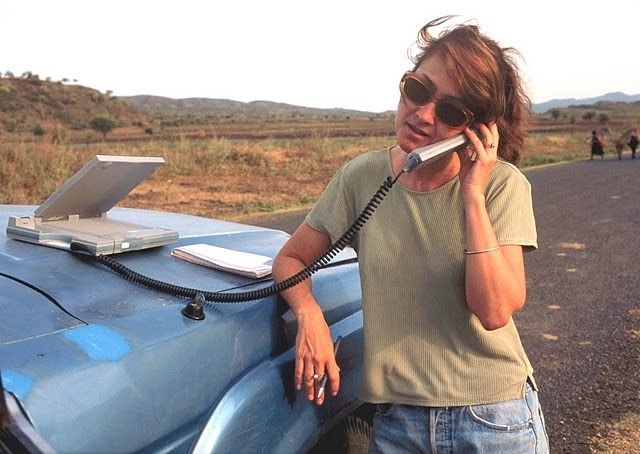
 (WOMENSENEWS)–The first question my rescuers asked after they pulled me from the room where I’d been held captive in Somalia was: “Did they rape you?” They seemed surprised when I said no. The assumption was that any woman held hostage for three weeks must have been sexually assaulted.
(WOMENSENEWS)–The first question my rescuers asked after they pulled me from the room where I’d been held captive in Somalia was: “Did they rape you?” They seemed surprised when I said no. The assumption was that any woman held hostage for three weeks must have been sexually assaulted.
People still assume I was raped, but they won’t ask in such a direct fashion. Instead, they say (usually in hushed tones): “Were you mistreated?” or “Did they abuse you?” Still, the meaning is clear. And the questions and the way they are posed underscore a couple of things: the rather morbid fascination people have with the idea of a tough female journalist falling victim to sexual assault on assignment; and the aversion to saying “rape,” as if it were shameful or something to be kept secret.
Like my rescuers, they seem surprised–and I suspect many don’t believe me–when I tell them I was not raped. They seem even more surprised to hear that rape was the least of my worries during my kidnapping, just as it has never figured prominently on the list of concerns I’ve had in the countless countries, wars and disasters I’ve covered since.
I worried–and worry–about my plane or helicopter being shot down; being trampled in a stampede; being hit by a stray bullet; getting kidnapped again; or stepping on a landmine. I even worry about a giant insect crawling into my sleeping bag.
Perhaps because rape is not a job-specific threat like bombs and missiles (and giant bugs), it doesn’t occupy my mind on assignment the way those other threats do. Based on conversations with other female journalists, I don’t think I’m unusual. Like our male colleagues, our main concerns are staying alive and keeping our limbs and brains intact.
A Big Worry
But as long as most assigning editors are male, rape will always be one of their big worries. Terry Anderson, a former Associated Press colleague who was held hostage in Beirut for seven years, told me this when we met some years ago. He said it was a male editor’s greatest fear: that a woman working for him could be sexually assaulted. That’s a problem, because as long as there are editors viewing their female correspondents as potential rape victims, it’s bound to affect staffing decisions.
What irks me about the discussion of sexual assaults of female journalists is the double-standard that often emerges in the conversation–mainly from non-journalists, but sometimes from journalists themselves. When my (many) male colleagues have been killed or injured on assignment, I’ve rarely heard anyone say of men: “They’re too macho and always run toward the action, so maybe we shouldn’t send guys into war zones.” Yet when a female is sexually assaulted, the questions immediately arise as to why a woman was there in the first place and whether it is wise to have a woman reporting from a dangerous place.
Rather than questioning the wisdom of sending women into potentially perilous duty or worrying for their safety, editors and news organizations should focus on preparing women (and men) for the threat of sexual violence and helping them avoid it.
Favorite Safety Tool
One of my favorite tools to travel with when I was based in sub-Saharan Africa, for example, was a doorstop which I’d shove under my hotel room door when I was in the room. It emitted an unbelievably loud shriek if anyone tried to open the door. I still consider it one of the best rape-prevention tools ever, in part because nobody could use it against me (unlike a taser gun or pepper-spray, for instance).
I also learned to adjust my back story to fit the circumstances. If I had to pretend to be married with children to be safe, I invented a husband and kids’ names. If I had to pretend to be a devout Christian, a Republican, a Democrat or Swiss, I did it. As far as my kidnappers knew, I was married with three children – something that made me appear more like their own mothers and sisters, and less like an independent Western woman for whom they would have less regard.
I wish some of my editors could have passed on some of these tips. They didn’t, so I figured things out on my own. It shouldn’t be that way. Safety isn’t contained in a medical kit or a flak jacket, which most news outlets happily hand out. It involves a lot of common sense and sometimes something as simple as a door stop–things that more journalists need to be equipped with before they’re sent on assignment.
Tina Susman was the Los Angeles Times bureau chief in Baghdad, Iraq, from 2007 until 2009, when she returned to New York to be a national correspondent. Prior to joining the Times she worked for the Associated Press and Newsday. She spent 11 years in sub-Saharan Africa, during which she covered the fall of the apartheid in South Africa, the Rwandan genocide, the Somali famine and war and conflicts in Liberia, Sudan, Sierra Leone, Nigeria and Angola, among others.

(WOMENSENEWS)–The first question my rescuers asked after they pulled me from the room where I’d been held captive in Somalia was: “Did they rape you?” They seemed surprised when I said no. The assumption was that any woman held hostage for three weeks must have been sexually assaulted.


